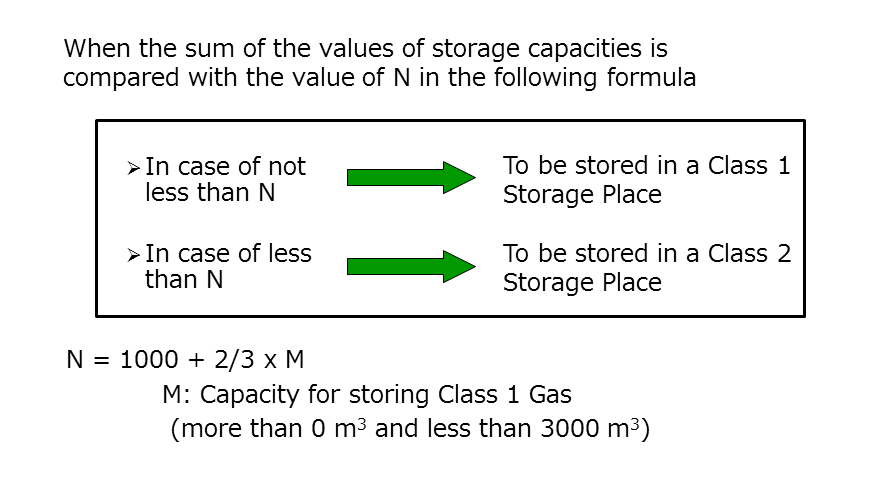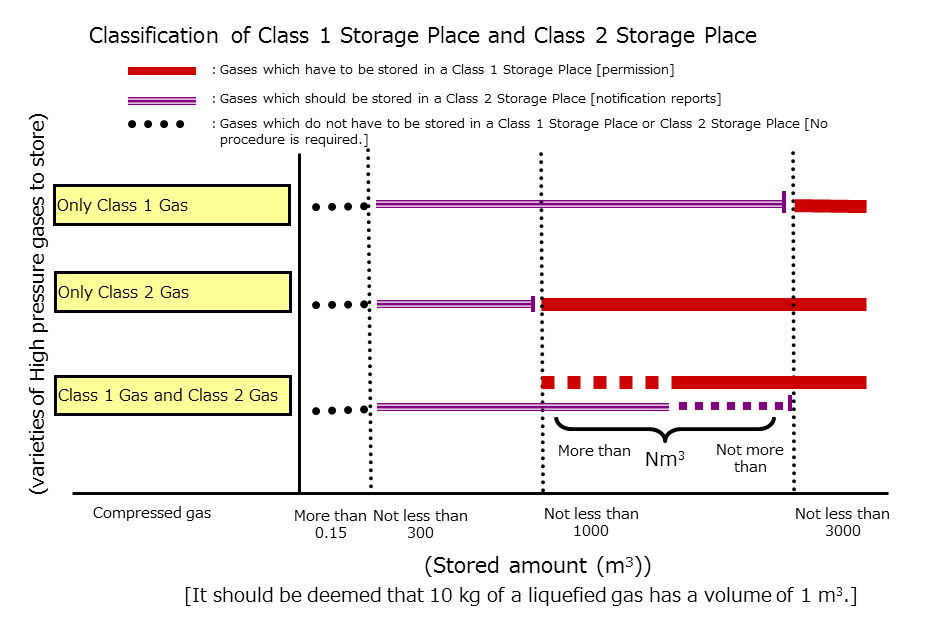Reference Clauses of the Act : Art. 16
It means a storage place of high pressure gas set up with the permission of the prefectural governor to store a volume of not less than 3000 m3 of only Class 1 Gas (or 1000 m3 in the case of only Class 2 Gas (gases other than Class 1 Gas)), (except where a Class 1 Producer or dealer registered pursuant to the LPG Act stores it).
Moreover, when both a Class 1 Gas and a Class 2 Gas are stored in a storage place, if the sum of their volumes is more than 1000 m3 and not more than 3000 m3, whether the storage place falls into the category of Class 1 Storage Place or Class 2 Storage Place should be determined as follows.

In addition, Class 1 Storage Place sometimes means a place for containers at which a space for containers is only shown or a storage vessel/storage tank is set up.
Moreover, said “volume” shall be deemed to be that of a gas in a state of being at a temperature of 0 degrees Celsius and a pressure of 0 Pa as prescribed in Article 5, paragraph (1), item (i) of the Act. It should be deemed that a mass of 10 kg of a liquefied gas has a volume of 1 m3.
In addition, in calculating volumes, when there are not less than two containers or two pieces of storage equipment (hereinafter referred to as “Equipment” in this section), their volumes should be summed up as described in item (1) or (2) below. However, when a high pressure gas (limited to inert ones) in fire extinguishing equipment set up for the purpose of fire extinguishing and high pressure gas other than the former are stored, their volumes should be calculated separately and should not be summed up.
Moreover, regarding a container for a fuel system fixed to a vehicle which uses a high pressure gas as fuel or a container filled with a volume of not more than 0.15 m3 of a high pressure gas, the volume of a high pressure gas in such container should not be added to a storage amount.
(1) Regarding high pressure gases in fire extinguishing equipment, their volumes should be summed up only when the pieces of the Equipment are connected with each other using pipes.
(2) Regarding high pressure gases other than high pressure gas in fire extinguishing equipment, their volumes should be summed up in the case of any of the following:
a. when the pieces of the Equipment are connected with each other using pipes; and
b. when the pieces of the Equipment are not connected with each other using pipes, in the case of any of the following:
(i) when the distance between pieces of storage equipment other than containers or between a container and storage equipment other than containers is not more than 30 m; and
(ii) when the distance between containers (including a vertical distance in a multistory building) is not more than 22.5 m (or the distance set forth in (a) or (b) below in the case of (a) or (b)):
(a) when a not less than 12-cm-thick wall of reinforced concreate construction or construction equivalent to or stronger than said construction (simply referred to as “Wall” in (b)) is set up between containers, which are effectively shut off from each other, if the containers are set up at a place where release of their pressures is not prevented when they burst (six surfaces of a place for the containers do not have to be shut, and its side or top may be opened if the containers are effectively shut off from each other; the same applies in (b)) (except for the case referred to in (b)), 11.25 m; and
(b) when the area of each of the places for containers is not more than 8 m2, if a Wall is set up between the containers, which are effectively shut off from each other, where the containers are set up at a place where release of pressures in them is not prevented when they burst, 6.36 m.
